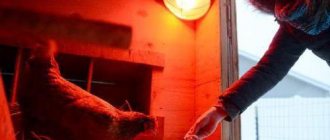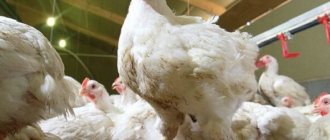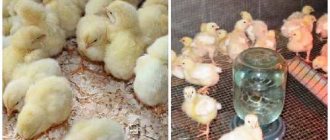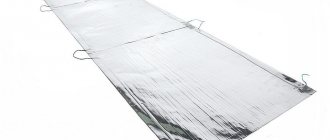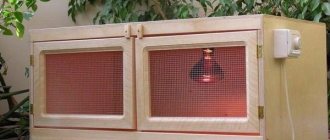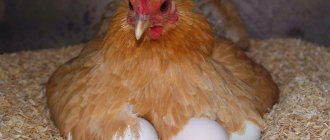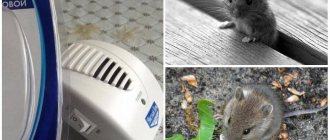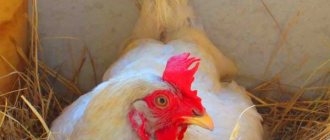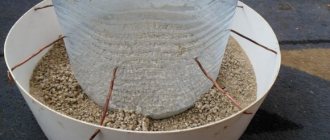Home » Articles about chickens » Heating a brooder for chickens
Newly born chicks require special housing conditions. Thermoregulation mechanisms at this age are not yet sufficiently developed, so heating is required in the brooder where the chicks are kept. To ensure this, various devices are used.
Heating options
To maintain a comfortable temperature for chicks in the brooder, use:
- infrared devices - ceramic, transparent and red lamps, IR film;
- heating panels;
- heating cables;
- incandescent lamps.
To provide temporary heating when cleaning the area where the chicks are kept, you can use a water heating pad or a bottle of hot water (wrapped in a cloth). An electric heating pad for animals will also work.
Infrared transparent and red mirror lamps
Infrared lamps consist of:
- flasks - it is made of impact-resistant glass, the inside is covered with a mirror coating that reflects the rays (it creates a directed flow of radiation);
- tungsten filament;
- screw base (most often - chambered for E27).
Screw the IR lamp only into a ceramic socket, since during operation the base heats up to high temperatures (the plastic may melt). To avoid burns from the surface of the flask, it is recommended to use a protective lampshade in the form of a grille.
The flask can be transparent (IKZ) or colored red/blue (IKZK/IKZS). Blue lamps are suitable for medical use, red lamps are used in poultry farming. This light has a positive effect on chicks - it helps strengthen the immune system, reduces the risk of pecking, and stimulates growth.
The IR lamp is ideal for heating chickens - it emits infrared waves. Their range is different - it is indicated in the characteristics. The shorter the waves, the brighter the glow and the larger the heated area. Long-wave equipment produces soft warmth and a dim glow. Power – 50-500 W. In medium-sized brooders, the most commonly used models are 150 and 175 W.
The light field in any of the options is insignificant (especially in the case of colored bulbs) - an additional light source is required. If there is a power switch, you can adjust the temperature.
IR lamps:
- compact;
- work silently;
- do not burn oxygen, do not emit hazardous substances;
- heats up quickly - you feel warm immediately after switching on.
Efficiency is close to 100%. Service life – from 6500 thousand hours. Installation is easy.
Ceramic lamps
When deciding what is the best way to heat a brooder for chickens, it is worth considering another option for infrared devices - a ceramic infrared lamp. Structurally, it is similar to a mirror one, but has an opaque bulb made of shock- and moisture-resistant hard ceramics. Such a device does not emit light at all - it only produces thermal radiation. Having chosen this device, it will not be possible to combine heating and lighting of a brooder for chickens. The length and diameter of the heating element are indicated in the specifications. For brooders, lamps with a power of 75 to 200 W are purchased. Service life – from 10 thousand hours.
IR film
Infrared heating film is most often mounted on the ceiling. Mounting on walls is also allowed. The first option is preferable - heating should be more intense in the center than around the perimeter. This allows you to differentiate between “warm” and “cold” zones. It is not advisable to install film on the floor - it will be difficult to maintain hygiene, and heating the litter soiled with excrement leads to oversaturation of the air with ammonia.
It is recommended to place reflective foil under the film - this increases the efficiency of the heater. Fastening to walls/ceiling is carried out using staples or self-tapping screws. For temporary fastening it is convenient to use regular tape. Optimal power is 200 W. The film, unlike lamps, does not heat up to high temperatures; touching the surface does not lead to burns (maximum temperature: +45°C). Efficiency – 98%. Subject to operating conditions, the service life is very long - 10-25 years.
Heating cable
Heating a chicken brooder with a heating cable is considered cost-effective. Carbon fiber (carbon) threads are placed in a silicone braid. The cable, containing 12 thousand threads, is equipped with sleeves and heat-shrinkable tubing for connecting the sections to the electrical supply wire. The cable is flexible (small bends are allowed), easily attaches to any surface, and has a very long service life - about 40 years. The ends are connected to the electrical wire and connected to the electrical network. To heat a medium-sized brooder, 12 m (120 W) is enough.
When installing the cable, it is mounted on surfaces that are not capable of melting when heated, do not conduct current, or are well insulated. The clamps should not pinch the carbon fiber. When you turn it on for the first time, check the degree of heating - do not allow the braid to soften. To regulate the temperature, you should use a thermostat.
If the installation rules are followed, it is possible to create ideal conditions for the chickens - the area is evenly heated and there are no temperature fluctuations. The cable instantly begins to heat up when turned on and cools down just as quickly when turned off.
Panel
When choosing how to heat a chicken brooder installed in a warm room, you can choose a heating panel.
The heating element is made in the form of a plate and is equipped with adjustable legs. Such a device can replace a hen. When the chickens are cold, they hide under the panel; when it’s hot, they crawl out from under it. These are the conditions closest to natural conditions for the development of young animals. Such a device does not contribute to heating the entire brooder; it creates a local comfort zone.
Chick brooder heating reactor
This heating element provides air heating by blowing. The compact housing with holes houses a heating element and a fan. The device operates in 3 power modes - 100/200/300 W. It is connected like a regular lamp (screwed into the socket). Light sources are LEDs (3 pcs.).
Incandescent lamps
If the brooder is located in a warm room, then 1-2 incandescent lamps with a power of 70 W can be used for heating (the quantity depends on the area). In the future, less powerful models will be required. You can also raise and lower the lamps to decrease/increase the temperature. Such heating will cost more than using IR lamps - the energy consumption will be greater, which will result in large sums if the device operates around the clock. An additional disadvantage is that glass flasks break easily. The advantage of this solution is that there is no need to additionally illuminate the brooder.
Heating pad
For pets, heating pads are available in a waterproof case - they are also suitable for chickens. The heating pads are safe, the risk of short circuit is reduced to zero. A remote control is used to regulate heating. Accuracy – ±2 °С. The removable cover makes it easy to maintain hygiene.
Conditions for keeping chickens
To raise chickens after the incubator, it is very important to maintain temperature and light conditions. Most often, devices for heating chickens combine both of these functions.
During the first days of the chicks' life, the chick brooder should maintain a temperature of 30 degrees. It is important that during the first five days of life there are no jumps and the temperature does not fall below 29. You need to monitor the temperature using a thermometer located slightly higher than the mat with bedding.
Starting from the sixth day, you can gradually cool the room. You can reduce the heating by one degree per day so that on the tenth day the chicken brooder is heated to at least 26 degrees.
For the next twenty days of the chicks’ life, the temperature should be gradually lowered by 3-4 degrees per week, so that by the first month the babies feel comfortable in a temperature of 18 degrees. The chicks are not yet ready for lower temperatures, so heating the chicks should continue.
Advice! When raising small chickens at home, it is very important to monitor the temperature and their behavior. For small birds, not only low temperatures are detrimental, but also too high. Therefore, when trying to warm them, it is important not to overdo it.
You can monitor how well the heating is provided by the behavior of each chicken. If the ambient temperature is normal, the chick will run around and interact with others. There will be activity in the brooder. If the temperature of the surrounding space is lower than necessary, the chicks will huddle in groups and try to warm each other. If you notice children huddled together, you need to urgently increase the heating intensity. Excess heat is also bad for the chicken. If the chick puffs up its feathers, opens its beak, and often and greedily drinks water, then you need to remove the device for heating the chicks to reduce the temperature in the brooder.
In addition, it is worth remembering that if you use one device for heating, the room will warm up unevenly and the far corner will be cold. Therefore, it is better to buy two heating lamps and distribute them on different sides. In addition to better heating, this will help avoid sad consequences if one of the lamps suddenly burns out.
In addition to lamps, you can make your own chicken heaters. Heating for chickens can be provided by heating pads filled with hot water or plastic bottles. It is important to wrap them with cotton wool and soft cloth so that the chicks do not get burned.
In addition to heating, it is equally important to organize proper lighting for the chicks. Just like lowering the temperature, chickens are introduced to ten hours of daylight gradually until they are at least two months old.
Light mode
The length of daylight hours is very important when breeding chicks. With proper selection of lighting, it is possible to regulate the activity of chickens
It is important that the temperature in the poultry house be high on the first day. Different lamps are used for the enclosure
In the first weeks, the chicken coop in which the chickens are kept is illuminated unevenly. A wakefulness zone is created in the area of drinking bowls and feeders. This area is constantly illuminated. Above it are lamps with reflectors with a power of 15-20 watts. Chicks should sleep in semi-darkness.
Scientists say that in the first 3 weeks of life, birds need constant lighting. It provokes increased activity and muscle growth.
Do chicken coops need to be insulated?
If you are serious about raising chickens, consider the air temperature at different times of the year. This way, you will keep the birds healthy, and they will lay eggs all year round. The favorable temperature for chicken is from 12 to 15 °C, and at 18 °C the bird lays eggs intensively. The temperature in the chicken coop should not be allowed to drop below 10 °C: the birds will begin to get sick, and feed consumption will increase. In the cold, a living creature spends vital energy to keep warm, so it needs more food.
In the first 21 days of the chickens’ life, the temperature in the chicken coop should be at least 21 °C, then it is gradually reduced to 16 °C.
Avoid high temperatures. It can lead to overheating and death of birds.
Is it possible to do without electrics?
An alternative to electric heaters are gas and stove heating systems that are traditional in our region. Each of them has its own advantages, disadvantages and conditions for rational use, but in any case, such heating of the room will help cope with any sudden drops in temperature.
Using a potbelly stove
An ordinary heating stove is the easiest way to heat a chicken coop, regardless of the climatic conditions of the region. This heating system consists of a metal combustion chamber (boiler) and a chimney. During the combustion of fuel, heat is released, which heats the surrounding air through the walls of the stove.
This heating system is quite practical. It does not require additional maintenance costs, and absolutely any non-toxic material can be used as fuel. However, building heating using a potbelly stove is not so simple. In addition to the boiler and ventilation pipe, the system requires strict compliance with all fire safety standards, since the potbelly stove requires heating with an almost open flame.
Advantages of a potbelly stove:
- cheapness;
- low fuel costs;
- practicality and ease of care;
- ease of installation of the heating system.
Disadvantages of a potbelly stove:
- low fire safety;
- you need to add fuel yourself;
- emits an unpleasant odor during operation.
Heating a chicken coop with gas
Gas heating is the most effective way to create the required temperature in the chicken coop. Gas heating systems can be of two types: water and convector. The water system is a chain of a boiler, heating elements and a flammable gas exhaust system. During the combustion of fuel, heat is released, which is used to heat water.
As water circulates through the system, it gives off its heat to the radiators, which directly heat the room. Convector heating is a system of point heating elements - convectors. They function like electric convectors, but the heating element is heated by burning gas in a sealed chamber of the device.
Advantages of gas heating systems:
- quick heating of the room;
- energy efficiency;
- high fire safety;
- absence of unpleasant odor during fuel combustion.
Disadvantages of gas heating systems:
- high cost of equipment;
- the need for constant monitoring of the health of the gas supply system;
- high cost of fuel.
Heating a chicken coop is one of the most important processes in caring for and raising poultry. Optimal climatic conditions for chickens throughout the year are the key to their good health and high egg production. This process must be approached as carefully as possible, since this directly affects the farming value of each individual on the farm. Therefore, the choice of the optimal heating system should be made not only on the basis of personal preferences, but also according to the efficiency and feasibility of the funds spent on it.
Electric lamp
pros
In addition to light, an electric lamp is considered a source of heat. Therefore, poultry farmers often use it to create a comfortable temperature for chickens.
The advantages of this invention include accessibility. This heater can be purchased at any hardware store.
Economical: The electric lamp consumes less energy than other bird warmers.
In addition to heat, light bulbs emit a lot of light. Moreover, it is easy to use.
Minuses
Among the disadvantages: low heat transfer, not designed for a large number of young animals. Short service life, which is usually about 1500 hours.
Using an electric lamp may cause a fire. Therefore, it should be mounted as far as possible from flammable materials.
When choosing such devices, you should pay attention to the power consumption, on which the output of heat and light will depend. For example, one 20 W light bulb will produce no more than 250 lm.
Useful tips
When insulating a chicken coop, here are some useful tips to help you:
- insulate the door of the room inside and outside to avoid drafts;
- if there are large gaps in the ceilings and walls, seal them with polyurethane foam so as not to waste insulation;
- when choosing a heating system, consider the area of the chicken coop and the number of birds;
- if the birds live in a brick building, you can put a “potbelly stove” in it. It is better not to install it in a wooden chicken coop;
- When building a home for chickens, first do natural insulation (walls, floors, doors, ceilings), and then install artificial heating. This will help retain heat and avoid heat loss in the future.
Combined
A combination lamp for heating chickens is a combination of ultraviolet and infrared radiation.
The positive aspects of such devices include good heat transfer and a beneficial effect on the chickens’ body. As well as disinfecting properties and the possibility of use over large areas.
However, it is worth considering that the cost of such devices is high compared to other heating devices. For example, in Moscow the price of one combined lamp varies from 600 to 1200 rubles.
Basic rules of use
You should use a thermometer to control the temperature. Newborn chicks require a high temperature - 35-37 degrees. Subsequently, it is recommended to reduce it by 1-2 degrees. At 9 weeks, chickens feel comfortable at a temperature of 18-21 degrees.
Which chickens can lay double-yolk eggs, reasons and how to solve the problemRead
To regulate the temperature, you can remove or bring the lamp closer to objects. To select the lamp power, you should focus on this ratio: 1 kilowatt of energy is required per 10 square meters. If the temperature in an unheated room is 10 degrees, 10 square meters will require 1 light bulb with a power of 600 watts.
The distance at which the heat source should be located is also important. Initially, this is done at a distance of 30-40 centimeters from the chicks.
After some time, the temperature is measured. If it exceeds 37 degrees, the heat source is moved higher.
You should have 2 lamps in your arsenal. If one gets damaged, it should be replaced in a timely manner. This will help keep the chicks healthy.
Other types
Other types of lamps can be used as heating:
- Luminescent. The positive aspects include their cost-effectiveness. But there are also negative indicators. The flickering, which is invisible to the human eye, affects birds. Their vision is sharper. Therefore, they accumulate in remote areas. In these places the litter quickly becomes dirty.
- LED. They eliminate the flickering effect. They are economical. It is possible to adjust the light power. The disadvantage is the high cost.
How to properly organize a brooder with your own hands?
In this case, you should pay attention to a brooder (English brood - sit on eggs) - a house for chickens, specially equipped and organized for raising young animals. The brooder must be equipped with:
The brooder must be equipped with:
- A good heating system, lighting, high-quality feeders and drinkers. Strength and ventilation are provided by fine-mesh gratings on the sides and floor of the cage (mesh size about 10 mm).
- All chick waste should easily fall through the floor grate into a metal or plastic waste container that can be quickly removed, washed, or disinfected. The entire structure of the brooder should also be well and easily cleaned, washed and treated with disinfectants.
- To raise young animals in the first days of life, protect them from drafts and maintain a higher temperature, it would be good to provide removable side walls made of easily washable materials, PVC panels or fiberboard, plywood, thick cardboard in cases of one-time use. For the first time, it is possible to install additional removable mats with dry bedding for half a cage.
- The brooder should be equipped with several infrared lamps; it is also desirable to have a thermostat that responds to changing conditions outside and adjusts the temperature inside the brooder.
- The door should be of such a size that it is possible to clean the inside of the brooder without much difficulty.
Well, the last point: the correctly calculated area of the brooder for the number of young birds. If the planting is too tight, it is possible that they may peck at each other, die, or develop leg pain due to insufficient movement.
Selection of characteristics
Before you start using infrared lamps for chickens, it is worth studying the characteristics of the device. One of them is wavelength. The shorter it is, the larger the area the radiation covers. For small areas, devices with a wavelength of 2.5-50 microns (medium wave) and 50-1000 microns (long wave) are chosen.
How powerful an infrared lamp for chickens should be depends on the heated area - for 10 square meters 250 W is enough. How many watts are required for a smaller area is calculated individually - models from 50 to 500 W are available for sale.
The entire spectrum of visible radiation passes through transparent colorless glass. The red color of the glass ensures filtration - the flask allows only the red spectrum to pass through. An additional effect is provided by mirror coating - a directed stream of rays is created. This is the design that is used to heat animals. The IKZK device is marked.
You can choose a cheaper model without mirror coating (with red glass). Devices with blue glass are used for medical purposes.
The model with a ceramic bulb is the most durable, but it is only suitable for heating and does not provide light radiation.
